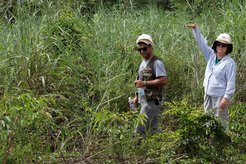Climate-Worsened Stresses Hinder Tropical Forest Recovery
A first-of-its-kind study looks at whether forests will be able to recover from climate change-worsened stresses like fire and drought, or if they’ll be permanently degraded. The new research is based on 14 years of measurements at the Tanguro ranch research station in the Brazilian Amazon by a team of scientists from Woods Hole Research Center (WHC), IPAM Amazonia and the Max Planck Institute for Biogeochemistry (MPI-BGC). It showed that the cycling of carbon and water between forest and atmosphere had recovered to pre-fire levels within seven years, but the forests themselves were still in decline—with large older trees still being lost and replaced by young, fast-growing species.

The study was published in Global Change Biology and was co-authored by WHRC scientists Paulo Brando, Michael Coe, and Marcia Macedo and involved MPI-BGC researchers Susan Trumbore, Olaf Kolle, and Mirco Migliavacca. The team examined postfire dynamics in a set of tropical forest plots that were experimentally burned from 2004 to 2010 (one burned every year, one burned every three years, and one unburned control plot), then damaged by a windstorm in 2012. Using two 100-foot flux towers, scientists measured how forest recovery influenced carbon emissions and absorption and water cycling. They also used LiDAR (light detection and ranging) to measure tree height and size.
Nearly ten years after the final burn, the forest plots remained degraded. Not only was total tree biomass reduced, but the plots remained vulnerable to wind damage, especially on the edges. That is a critical factor as deforestation cuts more edges into the Amazon’s canopy. Grasses also invaded the tree plots, leaving them even more flammable and vulnerable to long-term forest deterioration.
“We’ve done a great job of fighting Amazon deforestation, but degradation is still going strong as forests are weakened by clearing for agriculture, logging and other development. Our study shows these gashes in the canopy may leave permanent scars in reduced tree mass and carbon stocks. We’ll need more time to learn whether the plots will fully recover, or if a tipping point has been reached, pushing the forest into more of a forest-grassland hybrid,” Dr. Brando said.
“Few studies have documented so many different aspects of forest recovery following multiple disturbances. This allows us to improve predictions of future forest,” said Prof Susan Trumbore, a co-author of the study for the Max Planck Institute for Biogeochemistry. “This study is unique in combining so many measures of forest recovery following multiple disturbances, and adds to our ability to predict the trajectories of different forest functions into the future.”
The study has implications far beyond just the Amazon as agriculture, logging and development threaten forests around the world, and climate change hampers their ability to recover. A 2015 WHRC study showed climate change is expected to increase the frequency and intensity of disturbances such as windstorms and droughts. More frequent disturbances would hinder recovery of biomass and biodiversity, especially in landscapes becoming more fragmented by deforestation.
“While I was shocked to find these recovering forests, with half as much biomass, were cycling water and carbon just as fast as intact forest, we’ve lost the long-term carbon storage of the biggest, oldest trees. We can’t wait for forests to fall ill before we act to save them - policymakers should prioritize protecting intact, healthy, primary forests,” Dr. Coe said.
The Amazon has already lost 800,000 square kilometers of forest, an area equivalent to 1/10th of the continental United States, much of it to intentional burning to clear land for agriculture. WHRC scientists are continuing to study forest regrowth to help tropical countries achieve their climate goals to maintain and restore forest carbon stocks in protected forests, indigenous reserves, and private properties, as well as protecting biodiversity and forest ecosystem services.
